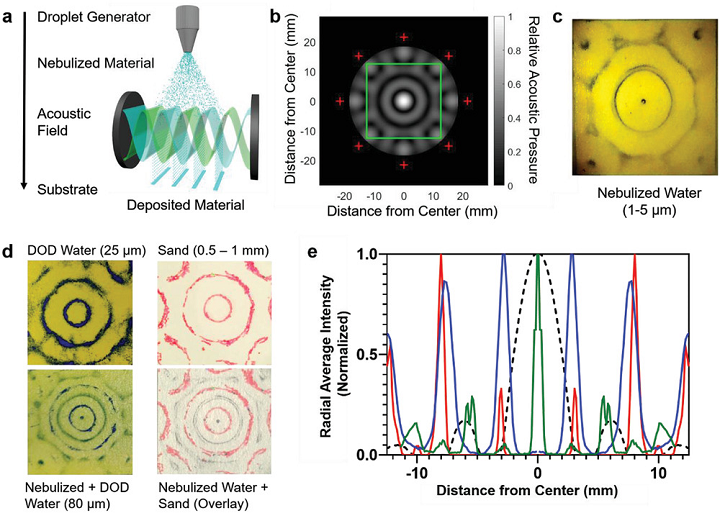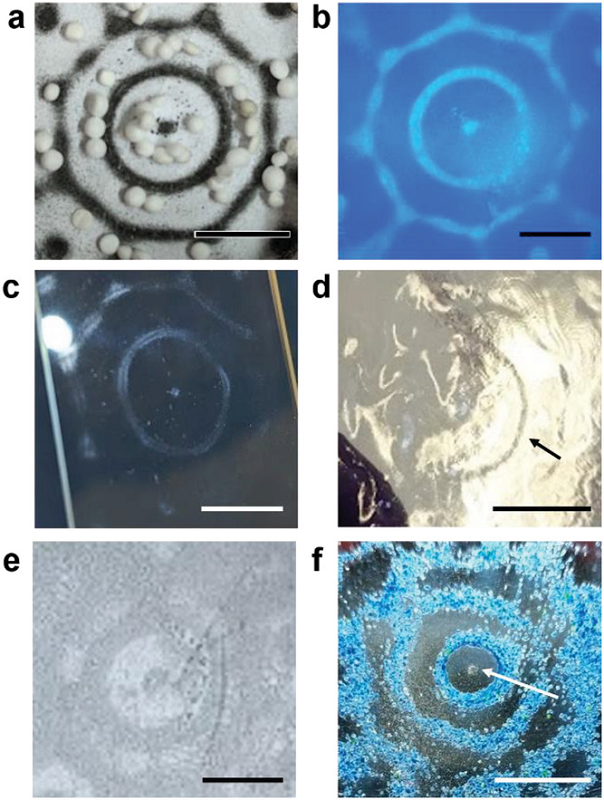I used to think acoustics was just about what type of room was best for a musical ensemble to play in, as that was a regular concern of mine when I was actively playing musical instruments on an almost daily basis from the ages of about 13-22. I wasn’t entirely wrong, though a bit pedestrian in my thinking: acoustics is a branch of physics focused on the study of mechanical waves in gases, liquids, and solids, including topics like infrasound, ultrasound, sound, and vibration. So, that’s anything to do with sound waves, whether we’re manipulating them to make better 3D prints, separating simultaneous overlapping sounds from different sources, or cloaking and tagging items.
A collaborative team of researchers from the University of Bath and the University of Bristol in the UK have been studying how to use sound to manipulate particles for a next-generation 3D printing method that’s faster and more precise. The team is using computer-controlled ultrasound to fabricate pre-determined patterns out of aerosol droplets or particles on surface substrates in a process known as sonolithography. This process could result in great benefits for various applications like printed electronics, industrial painting and spray coating, and even biofabrication.
“The interference of the waves generates an acoustic field with defined regions of high and low pressure. Droplets or particles moving through this field migrate to specific regions based upon this pressure distribution and the properties of the materials (e.g. size, density),” Dr. Jenna Shapiro, research associate in the School of Cellular and Molecular Medicine at the University of Bristol, explained in an interview with Design News.

a) Schematic representation of the sonolithography process. With a liquid material, droplets are generated, pass through an acoustic pressure field generated by ultrasonic standing waves, and are deposited into a pattern onto a substrate. Nodal localization is shown for larger blue particles, at the minimum amplitude points. b) The pattern can be predicted through simulation of the acoustic radiation forces. Here, the simulated pressures are shown for four transducer pairs, arranged in an octagon with 5λ (43 mm) spacing between the transducers. A 25 mm × 25 mm square region of interest in the center is outlined in green, corresponding to experimental images. Zero acoustic pressure areas (nodes) are black and maximum acoustic pressure areas (antinodes) are white. c) A still from a video of nebulized water being patterned onto water sensitive paper using the octagonal array, taken at t = 15 s, where the patterning has become clear. Contrast has been enhanced for visualization. d) Nebulized water (∅ 1–5 µm), water dispensed from a droplet-on-demand (DOD) generator (∅ 25 µm), and colored sand (∅ 0.5–1 mm) have been patterned with the same octagonal array. Nebulized water localizes to antinodes, whereas DOD water and sand localize to nodes. For the combined water image (bottom left), both nebulized and DOD generated water (here, ∅ 80 µm) have been patterned consecutively onto the same piece of paper. The photographs of sand (recolored to red) and nebulized water (greyscale) have been contrast enhanced and overlaid (bottom right) to demonstrate the different physical arrangements of these particles. e) Image analysis was performed to compare the deposition patterns of the water and sand with the simulated pressures in (b). The radial average pixel intensity of greyscaled photos of the nebulized (green) and DOD water (blue) and sand (red) were plotted against the distance from the center. Pixel intensity has been normalized to the maximum intensity at the darkest regions, such that peaks correspond to the areas with greatest density of patterned material. Also shown is the simulated acoustic pressures (black dashed), where the peaks correspond to the antinodes, and zero values to the nodes.
The researchers, who were inspired by the maker movement and advances in particle manipulation and ultrasonic levitation, worked together to develop, as Dr. Shapiro explained, “accessible fabrication tools using ultrasonic standing waves.” They published their results in a paper titled “Sonolithography: In-Air Ultrasonic Particulate and Droplet Manipulation for Multiscale Surface Patterning.”
The abstract reads, “Sonolithography is based on the application of acoustic radiation forces arising from the interference of ultrasonic standing waves to direct airborne particle/droplet accumulation in defined spatial regions. This approach enables reliable and repeatable patterning of materials onto a substrate to provide spatially localized topographical or biochemical cues, structural features, or other functionalities that are relevant to biofabrication and tissue engineering applications. The technique capitalizes on inexpensive, commercially available transducers and electronics. Sonolithography is capable of rapidly patterning micrometer to millimeter scale materials onto a wide variety of substrates over a macroscale (cm2) surface area and can be used for both indirect and direct cell patterning.”
Sonolithography uses arrays of acoustic standing waves in the air, which have been generated from ultrasonic speakers. Then, the materials are deposited, in the acoustic field-determined pattern, onto a substrate.
“It’s essentially as if the field is acting as a stencil or a mask, driving the materials into specific areas,” Dr. Shapiro explained.

Ultrasound and computer algorithms control how material settles into shape in a new type of printing called sonolithography invented by researchers at the Universities of Bath and Bristol.
Dr. Shapiro says that their sonolithography method can “print” patterned surfaces up to 20 square centimers in less than 30 seconds.
“The power of ultrasound has already been shown to levitate small particles. We are excited to have hugely expanded the range of applications by patterning dense clouds of material in air at scale and being able to algorithmically control how the material settles into shapes,” said Professor Mike Fraser from the Department of Computer Science at the University of Bath.
The team’s process allows for plenty of flexibility in the deposited materials, like proteins, mammalian cells, and aerosols, as well as in the substrate. Sonolithography is said to be most effective when the same pattern has to be repeatedly applied to multiple surfaces. Additionally, the method is modular, so any of the steps, like the patterning array or method of droplet generation, can be improved upon, or even just switched out.
Dr. Shapiro explained, “This means there is still plenty of room for innovation and improvement. In the fabrication space, we have shown that the material selection can be largely decoupled from the patterning itself, opening this up to a range of potential applications.”

Various materials and substrates patterned using sonolithography. Scale bars: 1 cm. a) Nebulized carbon-based conductive ink and expanded polystyrene beads (∅ ≈1.5 mm) on paper. b) Nebulized highlighter fluid on paper, illuminated by a handheld black light. c) Nebulized aqueous sucrose solution on glass. d) Nebulized water on a dehydrated calcium alginate film. An arrow indicates the second antinode from the center. e) Nebulized water on Parafilm. f) A size segregation effect observed with sand. Smaller dust fragments have been patterned to the center antinode.
The next step is to work on real-time manipulation of the acoustic field and subsequent patterning by adding dynamic control into the process.
“The objects we are manipulating are the size of water drops in clouds. It’s incredibly exciting to be able to move such small things with such fine control,” explained Professor Bruce Drinkwater, professor of Ultrasonics in Bristol University’s Department of Mechanical Engineering. “This could allow us to direct aerosol sprays with unheard of precision, with applications such as drug delivery or wound healing.”
Dr. Shapiro has a background in tissue engineering and biomaterials, so was most interested in sonolithography’s potential for biomedicine.
“Sonolithography enables gentle, non-contact and rapid patterning of cells and biomaterials on surfaces,” she explained. “Tissue engineering can use biofabrication methods to build defined structures of cells and materials. We are adding a new technique to the biofabrication toolbox.
“I am currently studying how sonolithography can be used to generate unique biomaterial microarchitectures and how these in turn impact cell-material relationships. I want to explore how this technique can be further developed, or used in combination with existing tools, toward creation of mammalian tissues for modeling and regenerative medicine.”
Subscribe to Our Email Newsletter
Stay up-to-date on all the latest news from the 3D printing industry and receive information and offers from third party vendors.
Print Services
Upload your 3D Models and get them printed quickly and efficiently.
You May Also Like
Formlabs Teams Up with DMG MORI in Japan
In late June, Nick Graham, Chief Revenue Officer at Formlabs, announced on LinkedIn that the company had partnered with DMG MORI, one of the world’s leading machine tool companies, to...
Nikon SLM Solutions & ArianeGroup to Collaborate on Large-Scale Metal 3D Printed Components
Just after announcing a collaboration with RocketLab, Nikon SLM Solutions is now announcing another with French space leaders ArianeGroup. The goal of their partnership will be to make metal additive...
Rocket Lab and Nikon SLM Solutions Sign MoU for New Large Metal 3D Printing Systems
Nikon SLM Solutions has signed a Memorandum of Understanding (MoU) with Rocket Lab. The aerospace manufacturing firm wishes to reserve two new “ultra-large format metal additive manufacturing platforms.” This is...
3D Printing News Briefs, June 14, 2025: Awards, CNC Integration, Sneakers, & More
We’re kicking off today’s 3D Printing News Briefs with some exciting news, as the winners of this year’s TCT Awards have been announced! Then it’s on to business, with Shapeways...
































